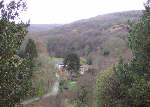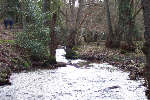The Village of Holford is about 14 miles from Bridgwater, on the A39, a small village of about 200 people. It is best approached by turning left into a narrow lane off the A39, shortly after some bollards in the middle of the road. The village is mainly situated on the left of the A39 (from Bridgwater) whilst on the right there is the village hall and cricket field.
Holford is a lovely picturesque village on the edge of the Quantocks. It is surrounded by beautiful Combes with wonderful names like Butterfly combe and Ladies combe, in the middle there is Holford Glen, once the home of a Huguenot silk factory. There have been people living in the area since the Iron age and just above the village can be seen Dowesbrough, an iron age hill fort, also known locally as Danesborough. The Romans also left evidence of their occupation and Roman coins have been found around the village. The history of the village is a fascinating study, and if you want to know more there is a lovely little booklet available from the church for the cost of £1:00 called "A Brief History of Holford" by A Hayman.
One of the explanations for the origin of the name of Holford is its geographical position. Holford was originally clustered around the old coach road where it dipped down to ford the stream, it is also situated in a narrow valley (locally 'combe'), or 'Hole'. And so we have the name of 'Holeford'.
Holford church, St Mary the Virgin
There has been a church on this site for over a thousand years and the church records go back to the 13th century. The existing small church was rebuilt in the 19th century and is in a good state of repair, the bells are still rung regularly by an active group of local campanologists The church yard is a beautiful place and there are a number of wild flowers growing in this area.
A walk round Holford
The best way to get the feel of the village is to walk. The most convenient place to start, if you have driven here, is from the car park next to the bowling green. From here if you turn left you approach the Old Minehead road, and on the corner there is the old dog pound where the local strays were housed. The story behind this is quite gruesome: the hunting dogs were housed on the Alfoxton estate here they were looked after by the huntsman. At this time meat for the hounds was hung in the trees, which attracted many of the local stray dogs who often unsettled the hounds. One night the huntsman was awoken by the sound of braying dogs and so went to investigate, unfortunately he did not put on his normal hunting garments and as a result was attacked and killed by his own dogs. To prevent strays causing such an occurrence again the dog pound was built.
From the pound you turn right and follow the drive towards the Alfoxton hotel, (it was here that Wordsworth lived with his sister Dorothy for 12 months; 1798/9). After about 1/4 mile there is a footpath on the right leading down into Holford Glen, following this you will come to a bridge across the glen. From the bridge you can see two streams converging, one of which has flowed from Holford Combe and the other from Hodders combe. It was in this Glen that the Huguenots settled and began their silk weaving factory. Holford Glen was also used during the filming of the film "Robin Hood Prince of Thieves" staring Kevin Costner. Remember the part where the arrow is going through the trees? Well this was where it was shot!
Back to our walk, once across the bridge follow the steps to the top and you come out onto Back Lane next to Dye Cottage, once probably used to dye the Huguenots silk. You can follow this lane to the left and it brings you back onto the A39 behind the Plough Inn. The Inn has a long history and is believed to be haunted by a wealthy Spanish gentleman of the 16th century who was supposedly murdered for his money. Walk around the building, being careful regarding the traffic, into Front lane. Follow this lane and you will see a mixture of house styles from modern to the old, Quantock house, with its beautiful thatched roof, is one of the oldest village properties. Just a little further and you come to the lychgate on your left, it is well worth going through and visiting the small village church with its flower strewn grave yard. Then continue up Front lane, past Back lane on your right, and if you look over the gate you can see the ruined cottages and factory of the Huguenots, now covered in ivy.
The road now forks. If you bear round to your right you will be back at the Bowling Green but if you go straight ahead, signposted Holford Combe, and past the thatched cottages there is a small green triangle. The road on your left, which is known as Stowey Lane, leads you back towards the A39 where there is a large layby, often with a snack van. If you carry on straight past a few more interesting houses you will find Combe House Hotel a good place for afternoon tea! This is another interesting property. It started out as a tannery, the stream also provided power for the big water wheel you can still see today. It was later used to provide electricity for the house and other nearby properties. Just past the hotel there is a gate leading you to Holford combe, which is well worth a visit, here there is a lovely grassy clearing - fantastic for picnics. Or you can explore the beautiful Hodders combe, which starts at the bowling green.
External sites about Holford
- Holford Village
- Holford Gardeners
- Holford History Society
- Holford Parish Council
- Baptisms, burials & marriages
transcribed from parish registers - Office For National Statistics (ONS) detailed data
Detailed Holford parish data - if no data available at parish level links are provided to data at ward and local authority levels. - Office for National Statistics (ONS) summary data
Summary statistics for a slightly larger area around Holford. - top of page










